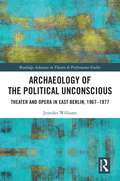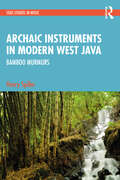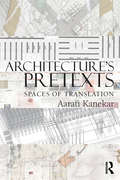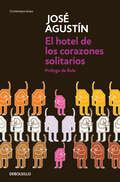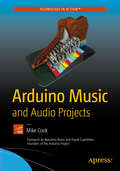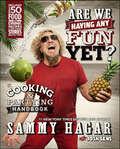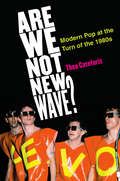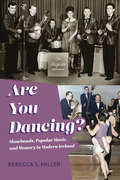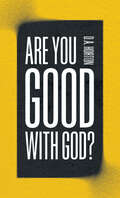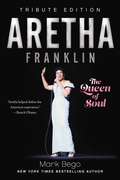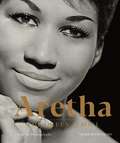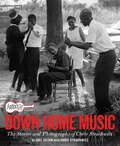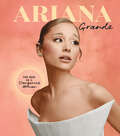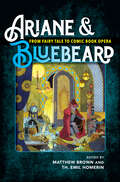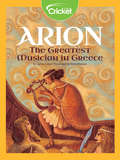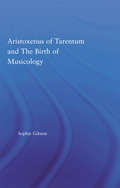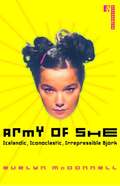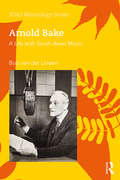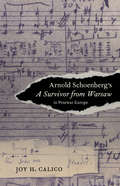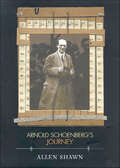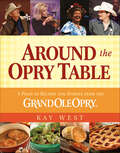- Table View
- List View
Archaeology of the Political Unconscious: Theater and Opera in East Berlin, 1967–1977 (ISSN)
by Jennifer WilliamsThis book investigates the aesthetic and political dialectics of East Berlin to argue how its theater and opera stages incited artists to act out, fuel, and resist the troubled construction of political legitimacy.This volume investigates three case studies of how leading East Berlin stages excavated fragmentary materials from Weimar dramatist Bertolt Brecht’s oeuvre and repurposed them for their post‑fascist society: Uta Birnbaum’s 1967 Man Equals Man at the Berliner Ensemble, Joachim Herz’s 1977 Rise and Fall of the City of Mahagonny at the Komische Oper, and Heiner Muller’s own productions of his trailblazing plays. In each instance, reused theatrical artifacts dialectically expressed the contradictions inherent in East German political legitimacy, at once amplifying and critiquing it. Illuminated by original archival research and translations of letters and artistic ephemera published in English for the first time, and engaging with alternative East German feminist epistemologies, this book’s critical investigation of culture and political legitimacy in the shadow of Germany’s fascist past resonates beyond the Iron Curtain into the twenty‑first century. Its final chapter examines how performative artifacts influence the process of political legitimation in more recent history, ranging from Checkpoint Charlie tourism to the January 6, 2021 US insurrection.This study will be of great interest to students and scholars in theater and performance studies, art history, musicology, German studies, anthropology, and political science.
Archaic Instruments in Modern West Java: Bamboo Murmurs (SOAS Studies in Music)
by Henry SpillerArchaic Instruments in Modern West Java: Bamboo Murmurs explores how current residents of Bandung, Indonesia, have (re-)adopted bamboo musical instruments to forge meaningful bridges between their past and present—between traditional and modern values. Although it focuses specifically on Bandung, the cosmopolitan capital city of West Java, the book grapples with ongoing issues of global significance, including musical environmentalism, heavy metal music, the effects of first-world hegemonies on developing countries, and cultural “authenticity.” Bamboo music's association with the Sundanese landscape, old agricultural ceremonies, and participatory music making, as well as its adaptability to modern society, make it a fertile site for an ecomusicological study.
Architecture's Pretexts: Spaces of Translation
by Aarati KanekarThe aim of this book is to expose readers to architecture’s pretexts that include literary narratives, film, theatre, painting, music, and ritual, as a bridge between diverse intellectual territories and architecture. It introduces a selection of seminal modern and contemporary architectural projects, their situation within the built environment, and their intellectual and formal situation/context as pretexts and design paradigms. Connections between diverse bodies of information will be cultivated along with the ability to posit consequential relationships for the production of architecture. Architecture’s Pretexts seeks to cultivate a vision for architecture that sponsors operative links between the discipline of architecture and those outside of architecture. Exploring the works of various architects including Guiseppe Terragni, Peter Eisenman, Peter Zumthor, Perry Kulper and Smout Allen, and Rem Koolhaas, this book provides the framework to understanding architecture through the lens of art. Key concepts discussed are: allegories, diagrams, form, material, montage, movement, musical ratios, narrative sequence and representation. A valuable tool, with over 75 black and white illustrations, for students and professionals interested in interdisciplinary methods of design thinking.
Archivo José Agustín: Y otros (muchos) textos sobre rock.
by José Agustín"José Agustín es una de las más notables manifestaciones del rock mexicano, probablemente mucho más potente y más significativa que buena parte de las bandas que han surgido en este país" RULO, tomado del prólogo José Agustín es una de las plumas más potentes de la literatura mexicana, representante de una generación de escritores cuyas letras fueron el instrumento ideal para dar voz a una época marcada por el rock, la psicodelia y el relajo. Este volumen, primero de una serie de textos poco conocidos del autor, reúne crónicas y ensayos de José Agustín. Del blues del Misisipi a las tornamesas de Tijuana, de la melancolía de José Alfredo al cine de Orson Welles, José Agustín explora con su libertad y estilo característicos los derroteros de la música, las letras y, por qué no, del cine para ofrecer al lector un atisbo a su visión personalísima del mundo. El resultado es un libro ecléctico y desmadroso, cuyo eje es la pasión incansable que su autor tiene por la música y la palabra.
Arduino Music and Audio Projects
by Mike CookThis book is for musical makers and artists who want to gain knowledge and inspiration for your own amazing creations. "Grumpy Mike" Cook, co-author of several books on the Raspberry Pi and frequent answerer of questions of the Arduino forums, brings you a fun and instructive mix and simple and complex projects to help you understand how the Arduino can work with the MIDI system to create musical instruments and manipulate sound. In Part I you''ll find a set of projects to show you the possibilities of MIDI plus Arduino, covering both the hardware and software aspects of creating musical instruments. In Part II, you learn how to directly synthesize a wave form to create your own sounds with Arduino and concludes with another instrument project: the SpoonDuino. Finally, in Part III, you''ll learn about signal processing with the Arduino Uno and the Due -- how to create effects like delay, echo, pitch changes, and realtime backwards audio output. If you want to learn more about how to create music, instruments, and sound effects with Arduino, then get on board for Grumpy Mike''s grand tour with Arduino Music and Sound Projects. What you''ll learn Hands-on musical instrument projects using Arduino Both the hardware and software aspects of creating musical instruments Signal processing and sound effects projects Explanations and inspiration from Arduino expert "Grumpy Mike" Cook Who this book is for Arduino and electronics enthusiasts who want to create music and sound projects, and musicians who want to tinker to create innovative instruments and sounds. Table of Contents 1. Basic Arduino 1. 1 Arduino Architecture 1. 2 Arduino Ripoffs, Clones, and Compatibles 1. 3 Arduino for audio 1. 4 Schematic schematics schematics 1. 5 Constructional techniques 1. 6 Adding extra parts to an Arduino 2. Basic MIDI 2. 1 What is MIDI? 2. 2 MIDI messages 2. 3 MIDI connections 2. 4 Software MIDI output 2. 5 Software MIDI input 3. More MIDI 3. 1 More MIDI messages 3. 2 System MIDI messages 3. 3 MIDI direct to USB 4. MIDI manipulation 4. 1 The MIDI setup 4. 2 Double Tracking 4. 3 The One Finger Wonder 4. 4 The Arpeggiator 4. 5 Echo & Delays 4. 6 MIDI Looper 5. MIDI Instruments 5. 1 I/O 5. 2 Sensors 5. 3 The Spoon-o-Phone 5. 4. The Theremin 5. 5 MIDI Air Drums 5. 6 MIDI Light Show 6. Project - MIDI controlled Harp player Video at https://vimeo. com/21024841 6. 1 The mechanical design 6. 2 The electronic design 6. 3 Using the harp by enabling MIDI 6. 4 Controlling the Harp player 7. Project - Dunocaster a MIDI output Guitar Video at https://www. youtube. com/watch'v=ehy9xgl4YCs 7. 1 Guitar chords 7. 2 The circuit parts 7. 3 The Schematic 7. 4 Construction 7. 5 The software 8. OSC and Friends 8. 1 The concept 8. 2 Sending a message 8. 3 Practical OSC 8. 4 Using PD and MAX 8. 5 OSC Theremin 8. 6 OSC Going wireless 8. 7 OSC Keyboard 8. 8 The Monome 9. Some more projects 9. 1 The MIDI Pendulum 9. 2 MIDI Footsteps 9. 3 MIDI Pendulum 9. 4 MIDI Glockenspiel 9. 5 MIDI Beater Total Part 1 Part 2 Direct Audio Synthesis - Using the arduino to generate sound waveforms. 10. The anatomy of a sound 10. 1 What makes a sound 10. 2 Why are some sounds different 10. 3 Fourier concepts 10. 4 Making a tune from a sound 11. Simple square wave output 11. 1 Why we need an amplifier 11. 2 Simple output amplifier 11. 3 Outputting a simple tone 11. 4 Using interrupts to output a tone 11. 5 Using interrupts to output multiple tones 12. Other wave shapes 12. 1 Direct calculation of the wave shape 12. 2 Using a look up table to define wave shapes 12. 3 Using built in PWM to output wave shapes 12. 4 Using external hardware to output wave shapes 12. 5 Reconstruction filters 13. The SpoonDuino project - Spoon based fun portable instrument Video at https://vimeo. com/38466551 13. 1 Concept 13. 2 Hardware 13. 3 Software - Arduino 13. 4 Wave table generati...
Are We Having Any Fun Yet?: The Cooking & Partying Handbook
by Sammy Hagar Josh SensIndulge yourself in the superstar rocker and #1 New York Times bestselling author’s raucous and delicious lifestyle with this bold cookbook and entertaining guide, complete with stories from a lifetime of food, signature recipes and drinks, and featuring lavish full-color photos.For over twenty years, Sammy Hagar has redefined the relationship between good food and good music through his iconic Cabo Wabo tequila brand, his popular chain of Cabo Wabo Cantina restaurants, and his newly launched rum—Sammy’s Beach Bar Rum. Now with Are We Having Any Fun Yet? any Sammy fan can eat, drink, and party like the Red Rocker himself, as Sammy shares his love of food, drinks, and rock-and-roll.Bringing you into the kitchen, behind the bar, and into the center of the party like never before, Sammy shares his deep passion for food and his secrets for rock-and-roll entertaining, including his favorite recipes from home, on the road, and his go-to vacation spots, Cabo and Maui. Coming along for the ride are a wealth of crazy tales, celebrity chefs from around the globe, and stories that reveal the inspiration behind his favorite recipes.Tracing Sammy’s culinary path through the decades, Are We Having Any Fun Yet? offers a fascinating glimpse into Sammy’s evolution as a cook and as a musician, showing how these twin passions have fueled each other, and how he brings a rock star attitude of simplicity and fun to everything he does in the kitchen. Of course, nothing goes better with a great meal than a good drink. Here are Sammy’s greatest drink recipes accompanied by true stories of the wild nights that brought them to life.With even more rock stories from the road and his table, over fifty food and drink recipes, and Sammy’s tips for entertaining like a rock star, Are We Having Any Fun Yet? gives fans everything they need to party the Cabo Wabo way.
Are We Not New Wave?: Modern Pop at the Turn of the 1980s
by Theo CateforisNew wave emerged at the turn of the 1980s as a pop music movement cast in the image of punk rock’s sneering demeanor, yet rendered more accessible and sophisticated. Artists such as the Cars, Devo, the Talking Heads, and the Human League leapt into the Top 40 with a novel sound that broke with the staid rock clichés of the 1970s and pointed the way to a more modern pop style. In Are We Not New Wave? Theo Cateforis provides the first musical and cultural history of the new wave movement, charting its rise out of mid-1970s punk to its ubiquitous early 1980s MTV presence and downfall in the mid-1980s. The book also explores the meanings behind the music’s distinctive traits—its characteristic whiteness and nervousness; its playful irony, electronic melodies, and crossover experimentations. Cateforis traces new wave’s modern sensibilities back to the space-age consumer culture of the late 1950s/early 1960s. Three decades after its rise and fall, new wave’s influence looms large over the contemporary pop scene, recycled and celebrated not only in reunion tours, VH1 nostalgia specials, and “80s night” dance clubs but in the music of artists as diverse as Rihanna, Lady Gaga, Miley Cyrus, and the Killers.
Are You Dancing?: Showbands, Popular Music, and Memory in Modern Ireland (Irish Culture, Memory, Place)
by Rebecca S. MillerFrom the mid-1950s to the mid-1970s, showbands were all the rage among Ireland's dancing audiences. Performing covers of rock 'n' roll and pop hits from American and British weekly Top 10 charts, they riveted their fans, dismayed many parish priests, and offered Irish youth a taste of modernism and pop culture from outside of Ireland.In Are You Dancing?, Rebecca S. Miller tells the story of how these working-class bands brought new sounds and choreographies to the Irish and Northern Irish pop landscape. Both as a response to and an agent in Ireland's changing economic landscape, showbands quickly grew into a hugely lucrative commercial industry. At the same time, they nudged open doors for Irish women to take to the stage as pop stars, rewarded a generation of entrepreneurs, and created the template for Ireland's popular music industry. Miller draws upon interviews with more than 80 musicians, agents, managers, fans, and clergy, to reveal the vast interplay of social, economic, and cultural changes that ensued with the Irish showband era.Drawing upon an extensive catalog of ethnographic and archival research, Miller presents an overlooked era of musical performances that revolutionized Irish entertainment.
Are You Good with God?
by D.A. HortonThe gospel according to hip hop. Yeah, that&’s a thing.Christian ideas often show up in hip hop music. Biblical themes and even Jesus Himself appear in the lyrics. But beneath all the God-talk, can a true gospel message be found?Pastor D. A. Horton (aka hip hop artist Azriel) says yes. And he wants you to know the gospel message is deep . . . powerful . . . theological . . . and surprisingly simple to comprehend. It all comes down to:God&’s designOur downfallGod&’s demonstrationOur decisionAre You Good With God? is a book of giant truths written in the raw and rhythmic style of hip hop. The poetry of the streets will energize you with the dynamic power of Scripture. Like every other global language, hip hop speaks to the human heart with truths that really matter. So if hip hop is your mother tongue, why not listen to what God is saying to you?
Are You Good with God?
by D.A. HortonThe gospel according to hip hop. Yeah, that&’s a thing.Christian ideas often show up in hip hop music. Biblical themes and even Jesus Himself appear in the lyrics. But beneath all the God-talk, can a true gospel message be found?Pastor D. A. Horton (aka hip hop artist Azriel) says yes. And he wants you to know the gospel message is deep . . . powerful . . . theological . . . and surprisingly simple to comprehend. It all comes down to:God&’s designOur downfallGod&’s demonstrationOur decisionAre You Good With God? is a book of giant truths written in the raw and rhythmic style of hip hop. The poetry of the streets will energize you with the dynamic power of Scripture. Like every other global language, hip hop speaks to the human heart with truths that really matter. So if hip hop is your mother tongue, why not listen to what God is saying to you?
Aretha Franklin: The Queen of Soul
by Mark BegoA frank examination of Aretha Franklin, Mark Bego's definitive biography traces her career accomplishments from her beginnings as a twelve-year-old member of a church choir in the early 1950s, to recording her first album at the age of fourteen and signing a major recording contract at eighteen, right up through untimely passing in 2018. Originally positioned to become a gospel star in her father's Detroit church, Aretha had a privileged urban upbringing; ;stars such as Mahalia Jackson, Dinah Washington, and Sam Cooke regularly visited her father, Rev. C. L. Franklin. It wasn't long before she was creating a string of hits, from "Respect" to "Freeway of Love"; and becoming one of the most beloved singers of the twentieth century. This New York Times bestselling author's detailed research includes in-person interviews with record producers Jerry Wexler, Clyde Otis, and Clive Davis, Aretha's first husband, several of her singing star contemporaries, and a rare one-on-one session with Aretha herself. Every album, every accolade, and every heart-breaking personal drama is examined with clarity and neutrality, allowing Franklin's colorful story to unfold on its own. With two teenage pregnancies and an abusive first marriage, drinking problems, battles with her weight, the murder of her father, and tabloid wars, Aretha's life was a roller coaster. This freshly updated and expanded biography will give readers a clear understanding of what made Aretha Franklin the "Queen of Soul."
Aretha: The Queen of Soul—A Life in Photographs
by Meredith OchsThis beautifully illustrated unofficial retrospective celebrates the Queen of Soul, Aretha Franklin, and reflects on her life, music, and legacy. Aretha Franklin&’s voice was legendary, unforgettable: deeply rooted in gospel, yet versatile enough to brilliantly interpret R&B, rock, soul, pop, and jazz standards, it fueled a six-decade career. Her vocal wallop was a mix of preaching, rebuke, and elation. From the languorous &“I Never Loved a Man (the Way That I Love You),&” to the funky &“Chain of Fools,&” to the fiercely feminist &“Think,&” to the definitive, demanding version of Otis Redding&’s &“Respect,&” Franklin&’s songs played out against the tumultuous sociopolitical backdrop of the late &’60s like a soundtrack meant to set things right. Her accolades were many: she received the Kennedy Center honor in 1994, won 18 Grammys®, was the first woman inducted into the Rock and Roll Hall of Fame, and performed for presidents and the Pope. Illustrated with 85 photos, and with insightful text from noted radio personality and author Meredith Ochs, Aretha explores the diva&’s life, from her formative years growing up in Detroit, to her singing and recording career from the 1950s until her untimely death in 2018, to her numerous honors, awards, and causes, including her advocacy for civil rights and the arts.
Arhoolie Records Down Home Music: The Stories and Photographs of Chris Strachwitz
by Joel SelvinA visual storytelling celebration of American roots music in its rich variety through unseen and newly scanned photographs by the founder of the legendary Arhoolie Records.Founded in 1960 by Chris Strachwitz, the one-man operation Arhoolie Records eventually produced more than four hundred albums during more than forty years in operation, exploring the far corners of American vernacular music—blues, gospel, Cajun, zydeco, hillbilly, Texas-Mexican norteño music, and more.From the very beginning, Strachwitz brought his camera along with recording equipment as he met and recorded now-legendary artists such as Lightnin’ Hopkins, Mississippi Fred McDowell, Clifton Chenier, and Big Joe Williams. This book collects more than 150 of his best, most intimate, and exciting images—many never-before-seen—each with rich captions by Strachwitz and award-winning music journalist Joel Selvin, along with a substantial 20,000-word essay by Selvin about Arhoolie, Strachwitz, and the music.INTIMATE AND AMAZING PHOTOGRAPHS: Although Strachwitz would always self-deprecatingly claim that the photographs he took while meeting and recording musicians were strictly documentary, and *maybe* of some use for a record sleeve later, they are much more than that. Lyrical, candid, real: His rapport with the musicians and their families is glowing and evident in these photographs.RIVETING MUSIC HISTORY PHOTO BOOK: These are never-before-seen photos, and photos like you’ve never seen before. Every image is from freshly remastered scans, and the authors dove deep into the Arhoolie archives to uncover images almost no one has had the chance to see. CRUCIAL AMERICAN MUSIC AND CULTURAL HISTORY: Strachwitz’s wide-ranging interest and unbridled enthusiasm for all sorts of roots music led to his crisscrossing the country from artist to artist based on recommendations, rumor, tips, radio broadcasts—the result being a portrait (in sound for the label, and image in this book) of vital American music in a wide range of genres. He has rich stories for each photograph and artist. AN INVALUABLE DOCUMENT: Arhoolie fundamentally shaped our understanding of American music. Renowned music writer Joel Selvin has not only worked with Strachwitz to draw out the stories behind the photographs, but he has contributed an invaluable long-form essay about Arhoolie, Strachwitz, and the label's cultural legacy to anchor this incredible book.Perfect for:Fans of American roots music, including the blues, folk, Cajun, Creole, zydeco, Mexican American border music, and moreFans of Lightnin' Hopkins, Mississippi Fred McDowell, Big Mama Thornton, Lydia Mendoza, Clifton Chenier, Flaco Jiménez, Mance Lipscomb, Narciso Martínez, Big Joe Williams, and the other fantastic artists whose records Arhoolie released over the yearsBirthday, holiday, graduation, or anytime gift for musicians and music loversCollectors of music history, American cultural history, Black history, and music photography books
Ariana Grande: The Rise of a Dangerous Woman
by Lisa Whittington-Hill Maura Johnston Joel Calfee Katie ConnorGet an insider&’s look at Ariana Grande's victorious performing career in this luxe hardcover gift book that's perfect for Arianators100+ stunning photos and insights from top music and culture writers explore the pop icon&’s music, style and cultural influence–and just how she&’s defied gravityThis stunning gift book immerses you in Ariana&’s world, examining her rise to stardom from her start as a young teen Nickelodeon star to the chart-topping, award winning musician and movie star she is today. Along the way this triple-threat entertainer has displayed resilience and strength, and her unabashed femininity and feminism have been a guiding light for her loyal fans.Her appeal is clear: she has a unique ability to blend artistry and activism (plus, that honeyed, four octave voice!).Inside you&’ll find: Ariana&’s many performances from singing the national anthem at local events to selling out worldwide tours Inspiration for her chart-topping, award-winning records that have sold over 90 million copies worldwide, and what makes her music so relatableAriana&’s sparkling style from red carpet appearances, tour performance outfits as well as her personal style Her business acumen in her career and the launch of R.E.M. Beauty, her own makeup lineThe impact of growing up in the spotlight on her mental health and personal relationshipsThroughout the photo-packed pages in this beautiful Ariana Grande book, fans will follow this dangerous woman&’s rise and rise to her status today as a beloved international icon. It&’s the perfect gift for any fan!
Ariane & Bluebeard: From Fairy Tale to Comic Book Opera
by Matthew Brown and Th. Emil HomerinMaurice Maeterlinck described his libretto Ariane et Barbe-bleue as "a sort of legendary opera, or fairy [opera], in three acts." In 1907, Paul Dukas finished setting Maeterlinck's libretto to music, and the opera's Paris premiere was lauded as a landmark in operatic history. Ariane & Bluebeard: From Fairy Tale to Comic Book Opera offers a comprehensive, interdisciplinary look at this historic opera, including its structure, reception, and cultural implications. This lively collection juxtaposes chapters from experts in music, literature, the visual arts, gender studies, and religion and philosophy with vibrant illustrations by comic artist P. Craig Russell and interviews with performers and artists. Featuring material from newly discovered documents and the first English translation of several important sources, Ariane & Bluebeard allows readers to imagine the operain its various incarnations: as symbolist show, comic book, children's fairy tale, and more.
Arion: The Greatest Musician in Greece
by James LloydArion is a famous musician in ancient Greek mythology. He loves to travel across Rome and Greece to play his music. While trying to sail home, he is robbed by a group of pirates! Fearing death, he escapes by jumping into the ocean. When all hope seems lost, he meets a dolphin that might be able to help.
Aristoxenus of Tarentum and the Birth of Musicology (Studies in Classics #Vol. 9)
by Sophie GibsonAristoxenus made an enormous contribution to the development of music theory in antiquity. Despite his Pythagorean upbringing, he rejected Pythagorean methods of harmonics which focused on the mathematical significance of musical structures and instead applied a scientific methodology appropriated from Aristotle. This volume studies the theories of Aristoxenus.
Army of She: Icelandic, Iconoclastic, Irrepressible Björk
by Evelyn McdonnellWearing thick glasses, speaking in her thick Icelandic accent, and, well, seeming a touch thick, Björk stormed the public consciousness in 2000 as an unlikely heroine in the experimental musical film Dancer In the Dark. Army of She is an in-depth look at the woman who first took the public stage twenty-three years ago, analyzing her rise from child prodigy to punk anarchist to New Wave novelty (as member of the Sugarcubes) to hit soloist to film star.
Arnold Bake: A Life with South Asian Music (SOAS Musicology Series)
by Bob Van Der LindenArnold Bake (1899–1963) was a Dutch pioneer in South Asian ethnomusicology, whose research impressed not only the most renowned Indologists of his time but also the leading figures in the emerging field of ethnomusicology. This long overdue biography sheds light on his knowledge of the theory and practice of South Asian music, as well as his legacy on the intellectual history of ethnomusicology. Bake spent nearly seventeen years in the Indian subcontinent and made numerous, irreplaceable recordings, films and photographs of local musicians and dancers. As a gifted Western musician, he studied Indian singing with Bhimrao Shastri, Dinendranath Tagore and Nabadwip Brajabashi, and successfully performed Rabindranath Tagore’s compositions and South Asian folk songs during hundreds of lecture-recitals in India, Europe and the United States. For the last fifteen years of his life, Bake taught Indian music at the School of Oriental and African Studies (SOAS), University of London; he was the first to do so at a Western university. Besides his numerous writings and radio presentations, he advanced his subject through his activities in British and international research associations. The history of ethnomusicology, especially as applied to South Asia, cannot be fully understood without regard to Bake, and yet his contribution has remained, until now, unclear and unknown.
Arnold Schoenberg's A Survivor from Warsaw in Postwar Europe
by Joy H. CalicoJoy H. Calico examines the cultural history of postwar Europe through the lens of the performance and reception of Arnold Schoenberg's A Survivor from Warsaw--a short but powerful work, she argues, capable of irritating every exposed nerve in postwar Europe. Schoenberg, a Jewish composer whose oeuvre had been one of the Nazis' prime exemplars of entartete (degenerate) music, immigrated to the United States and became an American citizen. Both admired and reviled as a pioneer of dodecaphony, he wrote this twelve-tone piece about the Holocaust in three languages for an American audience. This book investigates the meanings attached to the work as it circulated through Europe during the early Cold War in a kind of symbolic musical remigration, focusing on six case studies: West Germany, Austria, Norway, East Germany, Poland, and Czechoslovakia. Each case is unique, informed by individual geopolitical concerns, but this analysis also reveals common themes in anxieties about musical modernism, Holocaust memory and culpability, the coexistence of Jews and former Nazis, anti-Semitism, dislocation, and the presence of occupying forces on both sides of the Cold War divide.
Arnold Schoenberg's Journey
by Allen ShawnA composer's study and celebration of a difficult but influential artist, his work, and his timeProposing that Arnold Schoenberg (1874-1951) has been more discussed than heard, more tolerated than loved, composer Allen Shawn puts aside ultimate judgments about Schoenberg's place in musical history to explore the composer's fascinating world in a series of "linked essays--soundings" that are more searching than analytical, more suggestive than definitive. In an approach that is unusual for a book of an avowedly introductory character, the text plunges into the details of some of Schoenberg works, while at the same time providing a broad overview of his involvement in music, painting and the history through which he lived. Emphasizing music as an expressive art of rhythms and tones, Shawn approaches Schoenberg primarily from the listener's point of view, uncovering both the seeds of his radicalism in his early music and the traditional bases of his later work. Although liberally sprinkled with musical examples, the text can be read without them. By turns witty, personal, opinionated and instructive, "Arnold Schoenberg's Journey" is above all an appreciation of a great musical and artistic imagination in a time unlike any other.
Around the Opry Table: A Feast of Recipes and Stories from the Grand Ole Opry
by Kay WestCountry music and country cooking fans everywhere will savor this new official cookbook of the Grand Ole Opry and its members, featuring favorite recipes of country music legends past and present and the stories behind them.
Around the World in 57 1/2 Gigs
by Dave BidiniThe strengths of Bidini's two best-loved books, On a Cold Road and Tropic of Hockey, music and travel to unlikely places, come together in this account of his search for rock 'n' roll.When it looks as if the Rheostatics are breaking up after more than twenty years together, Dave Bidini is left feeling adrift from his moorings and decides to go on a very long road trip, playing solo and finding out about the state of rock 'n' roll around the world. Accompanied much of the way by his friend Al, who also has a solo act, Bidini sets out for London, England, his springboard for travel to Finland, Russia, China, Sierra Leone, and Ghana, punctuated by trips to Newfoundland and Gananoque in Canada, and to New York City.What Bidini finds is that the rock 'n' roll machine has not yet flattened the globe, as each place has taken what suits it from the West's dominant music and ignored the rest. Metal may have had its heyday in North America, but it still suits the quiet Finns just fine as a soundtrack for suicidal thoughts. In China, where Bidini plays with the Rheos-Not-Rheos as part of the Maple Rhythm Festival, he has to coach the crowd sitting quietly in plastic chairs how to clap rhythmically. In Russia, where live rock still lurks in hard-to-find places, the British band Smokie is far more popular than even the Rolling Stones, and the first Western band Mongolian audiences wanted to hear live was Boney M. In Africa, Bidini finds out just how far rock has wandered from its roots, and in Newfoundland, just how true it has stayed.Peopled with hosers, the über-hip, and the profoundly baffled, and brimming with tales of playing in strange venues to bemused locals and the odd drunk, Around the World takes readers on an unforgettable, ear-opening swing through the world of rock 'n' roll.From the Hardcover edition.
Arousing Sense: Recipes for Workshopping Sensory Experience
by Tomie HahnEngaging with sensory experience provides a gateway to the contemplation and cultivation of creativity and ideas. Tomie Hahn's workshopping recipes encourage us to incorporate sensory-rich experiences into our research, creative processes, and understanding of people. The exercises recognize that playfulness allows for a loosening of self while increasing empathy and vulnerability. Their ability to spark sensory endeavors that reach into our deepest core offers potentially profound impacts on art making, research, ethnographic fieldwork, contemplation, philosophical or personal introspections, and many other activities. Designed to be flexible, these living recipes provide an avenue for performative adventures that invite us to improvise in ways suited to our own purposes or settings. Leaders and practitioners enjoy limitless arenas for using the senses for explorations that range from personally transformative to professionally productive to profoundly moving. User-friendly and practical, Arousing Sense is a guide to how teaching through sensory experience can lead to positive, transformative impact in the classroom and everyday life.
Arrangements in Blue: Notes on Loving and Living Alone
by Amy Key"[Arrangements in Blue] reflects on a life spent as a single woman and how that affects friendships, freedom, domesticity, family, sexuality, the psyche, the self. It observes things about being alone that I have never seen or heard articulated before.... beautiful, effortless.... I haven’t been so obsessed with a book in a long time." —Dolly Alderton “The poet Amy Key’s first book might be the most hyped memoir of 2023 (or at least a close second to Spare)… This raw, gorgeous, pulsing memoir is…the harbinger of a real talent.” —Laura Hackett, Sunday Times [UK] Amy Key—a writer “of rare and strange magic” (Guardian)—probes the art of living without romance in this soul-stirring debut. When British poet Amy Key was growing up, she envisioned a life shaped by love—and Joni Mitchell’s album Blue was her inspiration. “Blue became part of my language of intimacy,” she writes, recalling the dozens of times she played the record as a teen, “an intimacy of disclosure, vulnerability, unadorned feeling that I thought I’d eventually share with a romantic other.” As the years ticked by, she held on to this very specific idea of romance like a bottle of wine saved for a special occasion. But what happens when the romance we are all told will give life meaning never presents itself? Now single in her forties, Key explores the sweeping scales of romantic feeling as she has encountered them, using the album Blue as an expressive anchor: from the low notes of loss and unfulfilled desire—punctuated by sharp, discordant feelings of jealousy and regret—to the deep harmony of friendship, and the crescendos of sexual attraction and self-realization. Finding solace in Mitchell’s songs, Key plumbs Blue’s track list for themes that resonate with her heart’s seasons. Listening to the song “California,” she explores the mixed emotions that come with traveling alone in a world built for couples; she juxtaposes the lonely lyrics of “My Old Man” with the pleasurable art of curating a perfect apartment for one; and with the utmost tenderness, she parses out her decision to not have children with the eloquent “Little Green.” Mapping the evolution of her early conceptions of love through her adulthood, Key offers a tender and nakedly candid celebration of the many forms of intimacy that often go unnoticed. An essential work for both the single and the partnered, Arrangements in Blue is a bold manual for building a life on your own terms.
